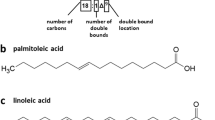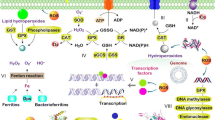Abstract
A submerged Aspergillus niger culture exposed to heat shock (40–41°C) for 1, 3, and 6 h acquires resistance to a more severe, lethal heat shock (55°C, 20 min). A general trend characteristic of a heat shock occurring during the trophophase or idiophase (regardless of its duration) is an increase in the trehalose level in the cytosol carbohydrate fraction and in the content of sphingolipids and phosphatidic acid in the membrane lipid fraction. Contrary to generally accepted views, no increase in the content of unsaturated fatty acid in the main phospholipid fraction, sterol level, and share of “bilayer” phospholipids was detected. The results obtained are discussed in terms of the current hypotheses concerning membrane protection under heat shock and our own suggestion on this subject.
Similar content being viewed by others
References
Lindquist, S., The Heat-Shock Response, Ann. Rev. Biochem., 1986, vol. 55, pp. 1151–1191.
Piper, P.W., Molecular Events Associated with Acquisition of Heat Tolerance by the Yeast Saccharomyces cer-evisiae, FEMS Microbiol. Rev., 1993, vol. 11, pp. 339–356.
Sinensky, M., Homeoviscous Adaptatio—A Homeo-static Process That Regulates the Viscosity of Membrane Lipids in Escherichia coli, Proc. Natl. Acad. Sci. USA, 1974, vol. 71, no. 2, pp. 522–525.
Hazel, J.R, Thermal Adaptation in Biological Membranes: Is Homoviscous Adaptation the Explanation?, Annu. Rev. Physiol., 1995, vol. 57, pp. 19–42.
Weete, J.D., Lipid Biochemistry of Fungi and Other Organisms, New York: Plenum Press, 1982, pp. 301–312.
Carratu, L., Franceschelli, S., Pardini, C.L., Koba-yashi, G.S., Horvath, I., Vigh, L., and Maressa, B., Membrane Lipid Perturbation Modifies the Set Point of the Temperature of Heat Shock Response in Yeast, Proc. Natl. Acad. Sci. USA, 1996, vol. 93, pp. 3870–3875.
Swan, T.M. and Watson, K., Membrane Fatty Acid Composition and Membrane Fluidity as Parameters of Stress Tolerance in Yeast, Can. J. Microbiol., 1997, vol. 43, pp. 70–77.
Tereshina, V.M., Resting Cells and Adaptation of Mycelial Fungi to Heat Shock, Doctoral (Biol.) Dissertation, Moscow: INMI RAN, 2006.
Thevelein, J.M, Regulation of Trehalose Metabolism and Its Relevance to Cell Growth and Function, in The Mycota, Brambl, R. and Marzluf, G.A., Eds., Berlin: Springer, 1996, pp. 395–420.
Tereshina, V.M., Thermotolerance in Fungi: The Role of Heat Shock Proteins and Trehalose, Mikrobiologiya, 2005, vol. 74, no. 3, pp. 293–304 [Microbiology (Engl. Transl.), vol. 74, no. 3, pp. 247-257].
Blumental, N.J. and Roseman, S., Quantitative Estimation of Chitin in Fungi, J. Bacteriol., 1967, vol. 74, pp. 222–225.
Nichols, B.W., Separation of the Lipids of Photosyn-thetic Tissues; Improvement in Analysis by Thin-Layer Chromatography, Biochim. Biophys. Acta, 1963, vol. 4145, pp. 417–422.
Keits, M., Techniques of Lipidology: Isolation, Analysis, and Identification of Lipids, Amsterdam: Elsevier, 1972 [Russ. Transl. Moscow: Mir, 1975].
Benning, C, Huang, Z.H., and Gage, D.A., Accumulation of a Novel Glycolipid and a Betaine Lipid in Cells of Rhodobacter sphaeroides Grown under Phosphate Limitation, Arch. Biochem. Biophys., 1995, vol. 317, no. 1, pp. 103–111.
Somogui, M., Determination of Blood Sugar, J. Biol. Chem., 1945, vol. 160, p. 69.
Brobst, K.M., Gas-Liquid Chromtography of Trime-thysilil Sugar Derivatives, in Metody issledovaniya uglevodov (Methods of Carbohydrate Research), Horlin, F.J., Ed., Moscow: Mir, 1975.
Seymour, I.J. and Piper, P.W., Stress Induction of HSP30, the Plasma Membrane Heat Shock Protein Gene of Saccharomyces cerevisiae, Appears not to Use Known Stress-Regulated Transcription Factors, Microbiology (UK), 1999, vol. 145, pp. 231–239.
Dickson, R.C. and Lester, R.L., Sphingolipid Functions in Saccharomyces cerevisiae, Biochim. Biophys. Acta, 2002, vol. 1583, pp. 13–25.
Cheng, J., Park, T.S., Fischl, A.S., and Ye, X.S., Cell Cycle Progression and Cell Polarity Require Sphingolipid Biosynthesis in Aspergillus niger, Mol. Cell. Biol., 2001, vol. 21, no. 18, pp. 6198–6209.
Sakai, H. and Kajiwara, S., Membrane Lipid Profile of an Edible Basidiomycete Lentinula edodes during Growth and Cell Differentiation, Lipids, 2004, vol. 39, no. 1, pp. 67–73.
Levery, S.B., Momany, M., Lindsey, R., Toledo, M.S., Shayman, J.A., Fuller, M., Brooks, K., Doong, R.L., Straus, A., and Takahashi, H.K., Disruption of the Glycosylceramide Biosynthetic Pathway in Aspergillus nidulans and Aspergillus fumigatus by Inhibitors of UDP-Glc:Ceramide Glucosyltransferase Strongly Affects Spore Germination, Cell Cycle, and Hyphal Growth, FEBSLett., 2002, vol. 525, pp. 59–64.
Siskind, L.J., Mitochondrial Ceramide and Induction of Apoptosis, J. Bioenerg. Biomembr., 2005, vol. 37, no. 3, pp. 143–153.
Jenkins, G.M., The Emerging Role for Sphingolipids in Eukaryotic Heat Shock Response, CMLS Cell. Mol. Life Sci., 2003, vol. 60, pp. 701–710.
Beck, J.G., Mathieu, D., Loudet, C., Buchoux, S., and Dufours, E.J., Plant Sterol in “Rafts”: A Better Way to Regulate Membrane Thermal Shocks, FASEB J., 2007, vol. 21, pp. 1714–1723.
Yu, R.K., Koerner, A.W., Scarsdale, J.N., and Preste-gard, J.H., Elucidation of Glycolipid Structure by Proton Nuclear Magnetic Resonance Spectroscopy, Chem. Phys. Lipids, 1986, vol. 42, pp. 27–48.
Wang, X., Devaiah, S.P., Zhang, W, and Welti, R., Signaling Functions of Phosphatidic Acids, Prog. Lipid Res., 2006, vol. 45, pp. 250–278.
Cazzolli, R., Shemon, A.N., Fang, M.Q., and Hughes, WE., Phospholipid Signaling through Phos-pholipase D and Phosphatidic Acid, IUBMB Life, 2006, vol. 58, no. 8, pp. 457–461.
Mumma, R.O., Sekura, R.D., and Fergus, S.L., Ther-mophilic Fungi: III. The Lipids of Humicola grisea var. thermoidea, Lipids, 1971, vol. 6, no. 8, pp. 589–594.
Author information
Authors and Affiliations
Corresponding author
Additional information
Original Russian Text © V.M. Tereshina, A.S. Memorskaya, E.R. Kotlova, E.P. Feofilova, 2010, published in Mikrobiologiya, 2010, Vol. 79, No. 1, pp. 39–44.
Rights and permissions
About this article
Cite this article
Tereshina, V.M., Memorskay, A.S., Kotlova, E.R. et al. Membrane lipid and cytosol carbohydrate composition in Aspergillus niger under heat shock. Microbiology 79, 40–46 (2010). https://doi.org/10.1134/S0026261710010066
Received:
Published:
Issue Date:
DOI: https://doi.org/10.1134/S0026261710010066




